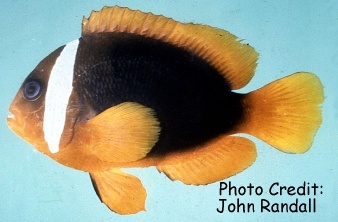
By Bob Goemans

Likely Reef Tank Suitable
Likely Fish-Only Tank Suitable
Range: Indo-West Pacific Ocean: Northwestern Australia.
Size: 5 inches (12 cm)
Natural Environment: Inhabits shallow fringing reefs at depths between 3 to about 30 feet (1 – 10 m) and usually found inhabiting various anemones where it feeds mainly on planktonic crustaceans (copepods, mysis, and shrimp larvae), and algae.
General Husbandry: Very rarely seen in the trade due to its limite collection areas. Has a brownish head and body with a reddish belly and fins with adults having a narrow white head band. Juveniles usually have up to three bands.
Best maintained in aquaria having live rock, hiding places, macroalgae, peaceful tankmates, and with a hosting anemone.
As to diet, will eat most regular aquarium foods, e.g., live fortified brine shrimp and/or finely chopped various frozen or fresh meaty foods such as mysis, squid, fish flesh, shrimp, clam, etc., and plant material, e.g., flake foods, especially those containing Spirulina and should be offered once or twice daily.
Taxonomy:
Order: Perciformes
Suborder: Labroidei
Family: Pomacentridae
Subfamily: Amphiprioninae
Genus: Amphiprion
FYI: In the wild, its hosting anemones are: Entacmaea quadricolor and Stichodactyla gigantea.
Females are larger than males.
If the female is removed, the male will change sex and one of the juveniles will become the new functioning male.
A member of the Tomato Complex.
Experience Level: Intermediate
Temperament: Peaceful
Diet: Omnivore
Coral Safe: Yes
Invertebrate Safe: With caution
Acclimation Time: 30 minutes+
Aquarium Environment: Reef or fish-only aquarium
Tankmates: Peaceful
Minimum Tank Size: 30 gallons
Temperature Range: 74 - 82°F (23 – 27°C)
Specific Gravity: 1.020 - 1.026
pH: 8.0 - 8.5
